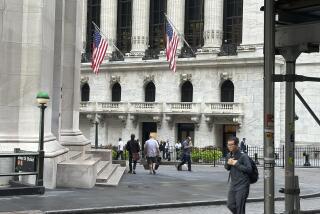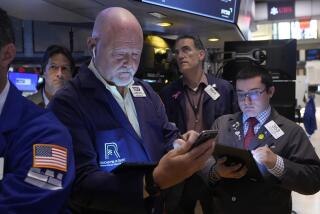If the stock market’s up, it must be rigged...right?
- Share via
Where was the stock market’s Plunge Protection Team -- or at least, the Dip Protection Team -- when we needed them on Friday?
Wall Street had a chance to make it three straight weeks without a single significant setback in the market. Instead, sellers had to ruin it: The Dow industrial average closed down 37.19 points, or 0.3%, to 10,741.98.
That wasn’t much of a loss, but it still was the worst the Dow has fared since Feb. 25. And it ended the week on a down note after most major stock indexes had pushed in recent days to fresh 17-month highs.
The steady uptrend this month has been remarkable for its lack of volatility. That has infuriated market bears, who can’t fathom why stock prices should have an easy time moving up -- or why they should be moving up at all -- with uncertainty over the economy still so high.
And so, the conspiracy theorists are out in force again. Depending on which investing-related sites you visit on the Web, this latest surge within the market’s now 1-year-old advance was the work of 1) the government, i.e., the Plunge Protection Team, trying to keep it all from collapsing, or 2) short-term traders, whose only goal is to sucker you in before it all collapses, or 3) both.
Yes, you’ve heard this before -- nearly every step of the way up over the last 12 months, in fact.
Joe Saluzzi, a veteran trader at Themis Trading in Chatham, N.J., has been asserting for much of the last year that short-term traders, not genuine investors, have been driving the market. If so, they’ve done an incredible job: The Dow is up 64% from its 12-year low in March 2009 and on Thursday hit its highest since Oct. 1, 2008.
I asked Saluzzi: Does he think this market is being manipulated? “I don’t know that I would use that word,” he says. “I couldn’t say someone’s doing something. I can’t prove it.”
And the opposite also is true: You can’t prove the market isn’t being manipulated, either.
Obviously, high-speed computers (albeit programmed by humans) are initiating plenty of trades every day on their own, based on second-to-second market shifts. Maybe there is very little real investing going on anymore.
Then again, I remember the same argument in 1987 during the first major incarnation of automated program trading: the boom in index arbitrage programs, which were designed to trade stock index futures and options against the underlying stocks, seeking to take advantage of short-term discrepancies in market values.
When the Dow plummeted 22.6% on Oct. 19, 1987, the computers were blamed. Many people thought the market was ruined forever. That was when the Dow was at 1,738.
It was a few months after the 1987 crash that the White House formed the President’s Working Group on Financial Markets, consisting of the heads of Treasury, the Federal Reserve, the Securities and Exchange Commission and the Commodity Futures Trading Commission.
The group, which soon got the nickname of the Plunge Protection Team, was supposed to provide a new layer of market oversight.
But since its formation, there have always been rumors that the team’s real role was to step in during times of market crisis and keep stocks afloat -- either with government money (which would be illegal) or by having Wall Street firms act on its behalf.
You might ask, of course, why the PPT would have allowed the tech-stock crash of 2000-2002, or why it couldn’t halt the 2008-2009 market dive before stocks’ losses reached their worst levels since the 1930s.
In any case, the allegations of market manipulation over the last year have been rooted in some admittedly suspicious trading, often involving late-in-the-day rallies in stock index futures contracts that seem to have no news trigger.
What the conspiracy theorists prefer to ignore, however, is that the economic fundamentals that are supposed to drive stocks have been largely supporting the bulls’ case.
The U.S. economy began to expand again in the second half of last year. Overall operating earnings of the Standard & Poor’s 500 companies started to rebound in the fourth quarter after nine straight quarterly declines (measured year over year). They’re expected to be up 36% in the current quarter, according to analyst estimates compiled by Thomson Reuters.
The manufacturing sector has been growing since August. Inflation remains subdued. The economy still is losing jobs, but net losses totaled 36,000 in February, down from 346,000 in July. And in the biggest surprise, retail sales were remarkably strong in February, ruining it for analysts who expected the consumer to be in prolonged hibernation.
Despite signs of continuing recovery, the pessimistic case on the economy is straightforward: Take away the trillions of dollars in help provided by the government and the Fed, the bears say, and there would be no sustainable recovery.
A big test of that thesis looms. The Fed, which has been regularly buying mortgage-backed bonds for the last year in an attempt to keep home loan rates down, will halt that program on March 31. If mortgage rates rise enough to slam the housing market, that will reinforce the belief that the recovery has been a mirage.
That remains the view of David Tice, a well-known market bear who had been warning for years that the U.S. was in a massive debt bubble destined to burst. The process is far from complete, Tice says.
He thinks the S&P 500, which closed at 1,159.90 Friday, will bottom at 400 by the time it’s all over.
Wouldn’t that mean we’re headed for economic collapse, I asked Tice. “Yes, we probably are,” he said.
Even people who reject the End Times scenario accept that the risks remain very high for the economy and markets.
No wonder so many Americans keep shoveling money into bonds while shunning the stock market.
Let’s face it: The easiest decision today is to be bearish on stocks. Once you’re in that camp you can stop worrying about what the market will do next. You don’t have to care. Even if it goes up you can convince yourself that another plunge is imminent.
The second-easiest decision is to view the market as hopelessly trapped in a relatively narrow range from here out, on the assumption that the economy will grow slowly at best.
If you think we’re in a trading range, then the market’s rally since Feb. 8 -- the S&P 500 is up 9.8% since then -- implies that this is a better time to be selling than buying.
The hardest decision is to be bullish and believe that the market will be higher by year’s end than it is now.
Jim Paulsen, chief investment strategist for Wells Capital Management in Minneapolis, thinks the market’s climb over the last year has been fueled by a series of “debunkings.”
The first phase of the rally, last spring, was the market debunking the likelihood of a second Great Depression, Paulsen says. The gains in the second half of 2009, he says, debunked the idea that the economy would fail to rebound significantly in that period.
This year’s advance is debunking “double-dip” recession expectations, Paulsen figures.
That leaves one bearish idea to be debunked, he says: the popular “new normal” forecast for the economy, which projects a long period of sub-par growth.
If the big surprise of 2010 is that the recovery gains traction instead of losing it, the new normal forecast will be in jeopardy, Paulsen says. And under that scenario, he believes stocks would have every reason to rally further by year’s end.
Paulsen’s bullishness is out of the mainstream, that’s for sure. But if you can’t trust a cabal of shadowy traders to keep stocks moving higher, a better-than-expected economy just might do the trick.
More to Read
Inside the business of entertainment
The Wide Shot brings you news, analysis and insights on everything from streaming wars to production — and what it all means for the future.
You may occasionally receive promotional content from the Los Angeles Times.










